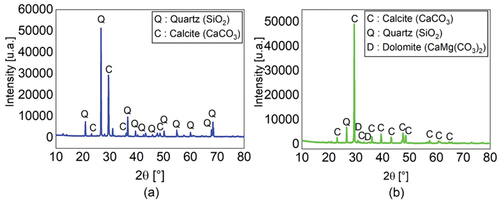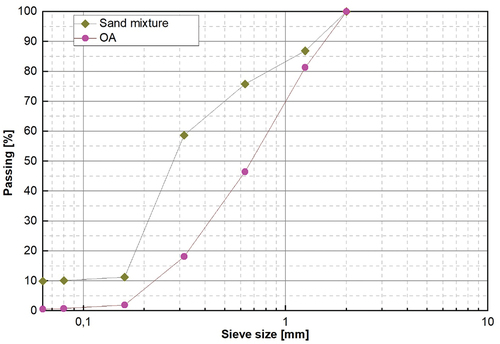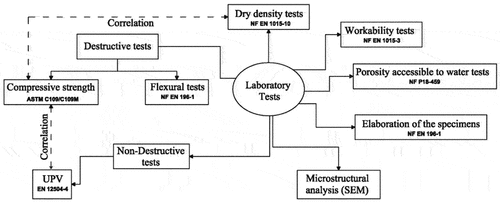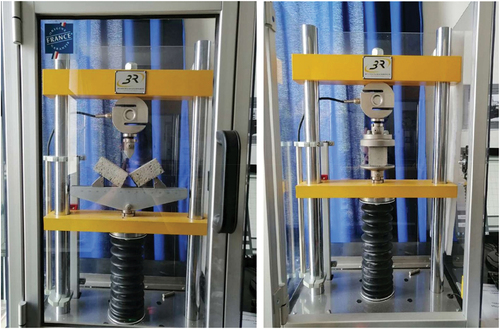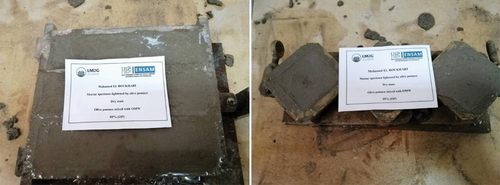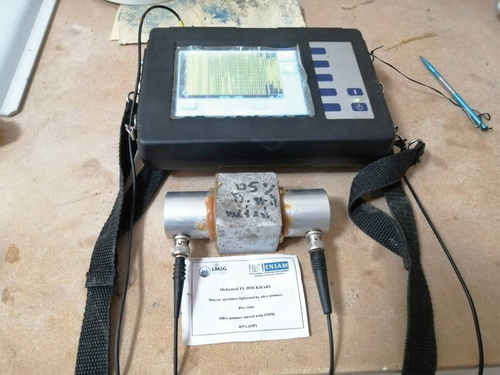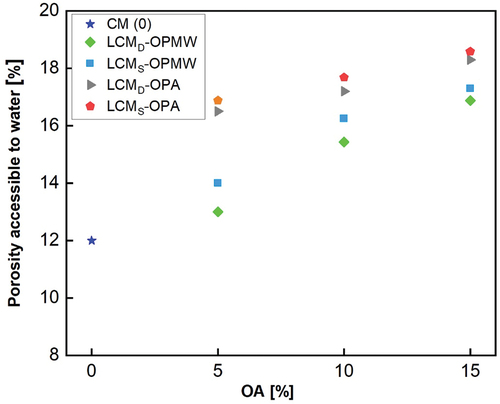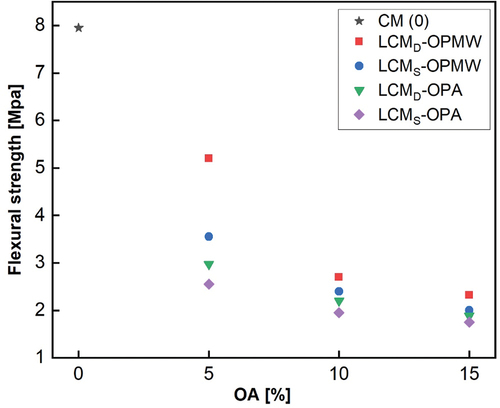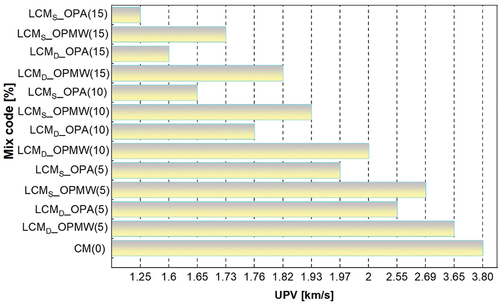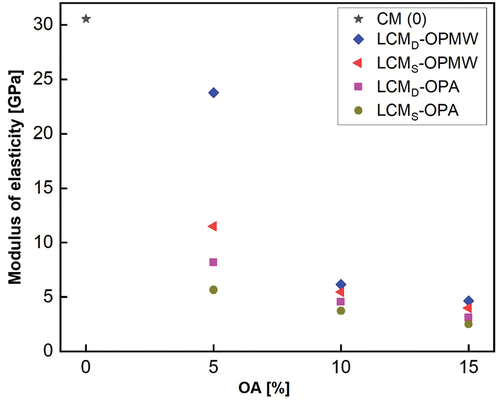 ?Mathematical formulae have been encoded as MathML and are displayed in this HTML version using MathJax in order to improve their display. Uncheck the box to turn MathJax off. This feature requires Javascript. Click on a formula to zoom.
?Mathematical formulae have been encoded as MathML and are displayed in this HTML version using MathJax in order to improve their display. Uncheck the box to turn MathJax off. This feature requires Javascript. Click on a formula to zoom.Abstract
This study investigates the potential use of olive aggregates (OA) in the production of cementitious materials as a substitute for natural sand to reduce excessive use of this resource. Two types of OA were used: OPA (olive pomace aggregates) and OPMW (OPA mixed with olive mill wastewater). The aim was to determine experimentally whether improvements in the mechanical properties of the produced lightened cement mortar could be obtained compared to the reference mortar. Laboratory tests were conducted on two series of mortar samples made by replacing 0%, 5%, 10%, and 15% of natural sand with both dry and saturated OA. The best results were observed in a mixture containing 5% of OPMW at the dry state, which had a marginal effect on the compressive strength of the produced mortar, reaching 33.50 MPa after 28 days of curing. However, microstructural analysis revealed low adhesion between the OA and the cement matrix at the interface transition zone (ITZ) after 28 days. Increasing the OA content was found to decrease the workability of the mixture while also increasing the porosity of the resulting lightened cement mortar. Additionally, the use of OA reduces ultrasonic pulse velocity and dynamic modulus of elasticity. Overall, the best results were obtained with the mixture containing 5% of OPMW at the dry state, which meets the standards for general use of building materials.
1. Introduction
Today, the construction industry contributes, more than any other time in the history of building sector, to a large depletion of natural aggregates used in mortar and concert mixtures such as sand, gravel, etc. These aggregates are subject to an intensive use which would certainly lead to their scarcity and price fluctuation. In this context, in order to contribute preserving natural resources, the use of agricultural waste materials as a partial substitution of sand can have a positive impact both on the environment (Prusty & Patro, Citation2015) and on the growth of the building sector. In fact, the rapid growth of agricultural waste has become a serious environmental issue. Hence, a correct waste management of these untreated wastes can reduce its impact on the environment (Usman et al., Citation2018). Facing this problem, researchers worldwide have recently focused on developing alternative materials from different agriculture by-products and having suitable mechanical and thermal properties needed for sustainable buildings. They have demonstrated the possibility of using corn straw/Stover, sugarcane bagasse, wheat and rice straw, sorghum straw/stalks, miscanthus, etc. as a raw material in the field of civil engineering, and especially as a partial substitute for cement or sand (Brasileiro et al., Citation2013; Liuzzi et al., Citation2017; Nait M’Barek et al., Citation2020; Prusty et al., Citation2016).
During the last decade, different studies were conducted to develop concretes and mortars based on agricultural wastes. For this purpose, a variety of innovative materials with good thermal properties have been developed, such as thermal insulating concrete with cotton fibers incorporation. Other authors have made a promising lightweight structural concrete by using oil palm shells as total or partial replacement of natural aggregate (Alengaram et al., Citation2013; Islam et al., Citation2016; Johnson Alengaram et al., Citation2011; Jumaat et al., Citation2015; Mo et al., Citation2016, Citation2015). Alfa vegetable fibers were also used to improve the mechanical properties of the repair mortar (Krobba et al., Citation2018). Results show that the use of 0.75% of Alfa microfiber increases the compressive and flexural strengths by about 15% and 30%, respectively. Several studies have found encouraging results regarding the use of olive waste, in its various forms (solid aggregate, ash, etc.), as a partial substitute for cement or natural sand used in mortar. The results of these published studies have been summarized.
In this context, a series of experiments were carried out to measure workability, setting time, compressive and flexural strength as a function of olive pomace ash replacing partially sand or cement (Al-Akhras & Abdulwahid, Citation2010). The results showed that setting time and workability of the mortar decreased with increasing ash content. Furthermore, the more percentage of the substitution of sand increases, the more the compressive and flexural strength increased. However, the mechanical strengths of the mortar decreased when replacing the cement with the olive pomace ash. This behavior is confirmed in another study aiming to evaluate comprehensively the fact of replacing cement by olive biomass fly ash (Cruz-Yusta et al., Citation2011). This study reported that up to 10% of Portland cement can be replaced by olive biomass fly ash while preserving the characteristics of the conventional mortar studied. Beyond this value, a continuous decrease in compressive strength was noted. Because fly ash develops pozzolanic activity over long periods of time. Olive Stone (OS) were also used to evaluate the physical properties of lightened mortar (Barreca & Fichera, Citation2013). Experiments showed that increasing the percentage of OS to 70% reduces the average thermal conductivity of cement lime mortar by more than 76% and decreases the density by about 30% compared to the reference mortar. Such a characteristic proves that the use of OS is suitable for thick insulating coatings or light aggregate concrete. However, beyond 70% of substitutions, the cement lime mortar lost its workability and was difficult to spread on vertical surfaces. Another study (Cheboub et al., Citation2020) reported that replacement of natural sand by the Crushed Olive Kernel aggregates (COK) was found to reduce both the compressive and tensile strengths. Moreover, the compressive strength range remains within the permissible values valid according to the RILEM recommendations for lightweight construction. It should be noted that according to authors, the decrease in flexural strength is apparently less significant than that observed for compressive strength.
The importance of discovering sustainable alternatives has increased significantly, and this is where using agricultural waste as a replacement for sand in building materials becomes significant. Our study aims to contribute to this field by examining the feasibility of using Olive Aggregates (OA) as a partial substitute for natural sand in cement mortar. In Morocco, olives are among the main tree fruit crops with great economic importance (Carr, Citation2013). However, during olive oil production, large amounts of waste are generated consisting of Olive Aggregates (OA). Generally, they are composed of solid aggregates known by Olive Pomace Aggregates (OPA) and Olive Mill Wastewater (OMW). This latter is a hazardous liquid effluent known for its environmental impact containing a high level of phenolic compounds and is considered the most polluting waste threatening groundwater and rivers. Given that this waste has been growing exponentially in recent (Elkacmi et al., Citation2017), this work aims to expand on previous research by conducting experiments to measure the workability, setting time, porosity, compressive strength, and flexural strength of cement mortar containing olive aggregates. The results will provide valuable insights into the potential use of olive waste in building materials and contribute to the ongoing discussion on the utilization of agricultural waste in construction. The research will help to develop local building materials while also addressing the growing concern of the depletion of natural aggregates. The experimental program consisted of the following steps:
Testing mortar samples casted at four replacement ratios of natural sand by OA:0% (reference mortar): 5%, 10%, and 15%;
Investigating the influence of OA on the mechanical properties of cement mortar in both fresh and the hardened state (workability, density, porosity, compressive, and flexural strength);
Performing non-destructive tests (ultrasonic pulse velocity (UPV) and dynamic modulus of elasticity (Ed)) to identify a correlation between destructive and non-destructive tests;
Analyzing the morphology and the porous microstructures of the mortar by using scanning electron microscopy (SEM).
The use of Olive Aggregates (OA) as a partial substitute for natural sand in cement mortar has the potential to contribute to the recycling of olive waste generated during olive oil production and the development of sustainable alternative construction materials using local resources. This study innovatively investigates the use of OA (OPA and OPMW) in cement mortar, thereby reducing the environmental impact of olive waste and developing building materials with appropriate mechanical properties. Therefore, this research can promote sustainable development in the construction sector, reduce the environmental impact of the construction industry, and provide a potential solution to the growing amount of olive waste in Morocco. The findings can also promote more environmentally friendly and sustainable building practices and contribute to the ongoing debate on the utilization of agricultural waste in construction materials.
2. Preparation and composition of mortar specimens
The study aimed to determine the mechanical properties of the lightened cement mortar (LCM) by varying the replacement percentage of natural sand by OA, both mixed and not mixed with olive mill wastewater (OMW). These substitutions were tested under dry and saturated conditions. To characterize the physical properties of the aggregates, X-ray diffraction (XRD) and granulometric analysis were conducted. The cement mortar was prepared and composed using two series of LCM specimens, with their respective mix designs presented in Table . The practical contributions of this study include evaluating the physical properties of the LCM specimens through workability tests, bulk density tests, porosity accessible to water tests, microstructure analysis, and mechanical tests. The academic contributions are significant as they involve conducting analysis to investigate the impact of specific parameters mentioned above on cement mortar performance (such as saturation state and percentage of OA). The parameters considered in this study are crucial to the development of the LCM and include factors such as curing time, water-to-cement ratio, and aggregate type. The research also provides insights into the behavior of the studied mortars compared to previous studies and standard specifications. This information will be of great value to academics, researchers, and industry professionals, as it can be used for the development of new materials and construction techniques. The laboratory conducted tests on three specimens of each mixture, using various experimental procedures described in detail in the study.
Table 1. The chemical composition of the cement
Table 2. Physical characteristics of the OA and the natural sand used
Table 3. Composition of lightened cement mortars
2.1. Characterization of natural and organic aggregates used
In the present study, the raw material used in making mortar specimens are mineral aggregates and organic aggregates. The former one consists of cement and natural sand. The compound Portland cement class is CEM II/A 42.5 with density and Blaine surface of 990 Kg/m3 and 4145 cm2/g, respectively. The cement was provided by ASMENT TEMARA MAROC company. Its chemical composition is summarized in Table . The natural sand (fraction of 0/2 mm) used consists of 60% of quarry sand corrected by 40% of fine sea sand. X-ray diffraction (XRD) measurement (Figure ) shows that the quartz and calcite are the abundant minerals present in this sand mixture.
Lightweight Organic Aggregates used in this work are Olive Pomace Aggregate (OPA) derived from olive oil production factories located in the region of Beni Mellal in the center of Morocco. According to the storage method, OPA are available, as shown in Figure , either mixed or separate from Olive Mill Wastewater (OMW). After being washed and dried under sun rays, the two types of aggregates are grinded using ball mill and then passed through a 2 mm sieve in order to obtain a homogeneous mixture with particle sizes similar to natural sand (0/2 mm). Here, the OA has not undergone any chemical or thermal treatment. The physical characteristics of the OA and natural sand used are detailed in Table . A granulometric analysis was carried out on the raw materials used according to CitationNF EN 933–1. The results are presented in Figure .
2.2. Mortar mixing and composition
In order to investigate the mechanical performances of mortar lightened by OA, two series of Lightened Cement Mortar (LCM) specimens were elaborated based on the following parameters:
Types of OA used: OPA and OPMW (OPA mixed with OMW);
The percentage of substitutions (by weight) of the natural sand by the OA: 0%, 5%, 10%, and 15%;
The saturation state of the OA: Dry state (D) and Saturated state (S).
Based on these parameters, the following notations are used:
LCMD_OPA and LCMS_OPA designate cement mortar lightened only with OPA at dry and saturated state, respectively;
LCMD_OPMW and LCMS_OPMW designate cement mortar lightened with OPMW at dry and saturated state, respectively.
The mix designs of the mortar mixtures are shown in Table . Here, we notice that depending on the amount of the OA in the mixture, the ratio changes as follows:
An experimental setup was designed to achieve workability between the values given in CitationNF EN 1015–2. The mortar mixture parameters used were 1, 3 and 0.5 (by weight) for cement, sand and water, respectively (CitationNF EN 196–1).
When elaborating LCM in the saturated state, the OA were kept in completely sealed plastic bags containing water for 24 h. The mixing water (efficient water) includes the total water minus the water used to presaturate the aggregate, which is the amount of water absorbed by the OA. It should be noted that prior to each mixing, moisture from the OA surface was removed. However, for LCM in the dry state, the amount of total water was adjusted to consider the water absorbed by the OA. In fact, the mixing water (efficient water) and absorbed water were added at the same time while the mixing.
For mechanical tests, three specimens of each mix were used to measure compressive and flexural strength of the cement mortar.
3. Experimental tests and analysis
3.1. Experimental tests and procedures
Different experimental tests, as shown in Figure , were performed at the laboratory in order to evaluate the physical properties of the LCM specimens. Hereafter we give a succinct description and the material used for each experiment.
The workability and bulk density tests versus the amount of OA: the objective is to check the impact of using different quantities of OA as a substitute for natural sand, on the workability of fresh mortar. Here, the flow table test is used. The reference mortar with a fresh bulk density above 1200 kg/cm3 was prepared, according to CitationNF EN 1015-3, to have a consistency of 175 mm ±10 mm. The average dry bulk density of the mortar mixtures was measured after 28 days of curing according to the CitationNF EN 1015-10.
The porosity accessible to water: The porosity accessible to water tests Pa were conducted according to the CitationNF P18-459 standard recommendations, on three cubic specimens of 50 mm. Calculations of the porosity (Pa) were done using Eq.2
(2)
(2)
where Mair is the mass of the air-saturated sample, Md is the dry weight of the sample and Mw is the mass of the sample in water using hydrostatic weighing.
(iii)The microstructure analysis: the objective is to study and verify changes in the microstructures of the composite mortar after 28 days of curing. The test was realized by using BRUKER HIROX SH4000M Scanning Electron Microscopy (SEM). A sample of 5 mm cubic of the lightened cement mortar was prepared and glued to a motorized 3-axis SEM plate by double-sided carbon tape. Then, metalization process of the sample was carried out by forming a thin conductive layer on the specimen surface.
(iv)Destructive tests: LCM specimens were undergone compressive strength tests at different curing ages of 3, 7, and 28 days and flexural strength tests at 28 days of curing (Fig. ). As shown in Fig. , cubic specimens measuring 50 mm × 50 mm × 50 mm were used for compressive strength tests following the guidelines of CitationASTM C109/C109M, and 40 mm × 40 mm × 160 mm prism specimens were elaborated for flexural strength tests according CitationNF EN 196-1. The mixture preparation procedure and storage of the specimens were done in accordance with the CitationNF EN 196-1.
(v)Non-Destructive tests: to evaluate the mechanical properties without influencing the mortar structure, the Ultrasonic Pulse Velocity (UPV) measurement technique was used. The experimental setup used is the Matest brand ultrasonic wave generator connected to a transmitter and receiver sensor with a frequency of 55 kHz (Fig. ). UPV allows evaluating the uniformity and mortar quality by indicating the presence of voids, cracks, and discontinuities. Furthermore, when UPV is applied according to the NF EN Citation12,504-4 standard, a simplified linear model, representing the strength of each mortar mixture, can be obtained between UPV measurements and destructive compressive tests.
3.2. Experimental results and analysis
The methodology was carefully designed to ensure the accuracy and reliability of the obtained results. Various tests and methods were employed to analyze the data collected during the study, including workability tests, dry density measurements, porosity tests, as well as destructive and non-destructive tests. The data collected from these tests were analyzed by comparing them to the results of the reference mortar and by examining the findings from previous studies in the literature. Statistical methods such as mean values, standard deviations, and regression analysis were used to analyze the data. The results of these tests and analyses were used to explain and discuss the relationships between different parameters.
3.2.1. Workability test of cement mortar
Workability tests were conducted to examine the influence of different amounts of OA on the workability of fresh mortar. This was reflected in the results obtained, which were achieved by preparing a reference mortar and several mixtures of OA and measuring their workability using the flow table test. To ensure uniform mixtures, we maintained a consistent mixing process during the workability tests and carefully controlled the testing conditions. We also accurately measured the flow of each mixture and repeated the tests multiple times to ensure the reliability of the results. The workability values measured for the elaborated specimens are shown in Table . As a primary finding, the formulation parameters used in this study, such as saturation state, the percentage, and the types of OA appear to play a significant impact on the mixtures workability of the elaborated mortars. Firstly, we note that the relationship between OA additions (OPA and OPMW) and workability is inversely proportional for all mixtures. In other words, as the percentage of OA increases, the mixture workability decreases. This behavior is in accordance with an experimental study dealing with a cement mortar based on agave biomass ashes (González-López et al., Citation2015). In the second hand, the workability of LCM specimens prepared with OPMW is higher than that of mortar specimens lightened by OPA. This behavior can be explained by the fact that OPA absorb more water than OPMW. Furthermore, the amount of water fixed during the storage period of OPA and OMW would contribute significantly to the workability of the mixture.
Concerning the saturation state of the LCM specimens, it seems that LCMS ones have lower workability values than LCMD. This is due to the extra quantity of water added, during mixing, to compensate the water absorbed by OA used in dry-state conditions. However, for LCMS, the OA used in the saturated state have only recovered a fraction of their internal water during the mixing process.
LCMS_OPA(5) exhibited a significant reduction in workability, measuring 133.75 mm, compared to the reference Mortar workability of 180 mm. In accordance with the workability values defined in EN 1015–2 (), LCMD_OPMW(5) reached a value of 176 mm, which is only 2.3% less than the reference value.
3.2.2. Dry density of cement mortar
In the dry bulk density tests, we followed standard procedures and ensured that the samples used in the tests were representative of the larger mixture, and were kept under appropriate conditions throughout the testing period. Figure shows the evolution of the average dry bulk density of the LCM specimens versus the percentage of OA in the mixtures over a period of 28 days. As a first observation, once the OA are incorporated in the mixture, the density of all specimens drops considerably compared to the reference mortar density. This behavior was expected since the density of OA is lower than that of the natural sand. Furthermore, the dry bulk density of mortars decreases as the amount of OA increases in the mortar mixture. These results are in line with the tendencies reported in some studies using other types of agriculture by-products (Alkheder et al., Citation2016; Alsalami, Citation2017; Barreca & Fichera, Citation2013; Boumhaout et al., Citation2017; Cheboub et al., Citation2020; Corinaldesi et al., Citation2016; Raut & Gomez, Citation2016).
Figure 8. Variation of the dry density according to the substitution percentage of natural sand by OA.
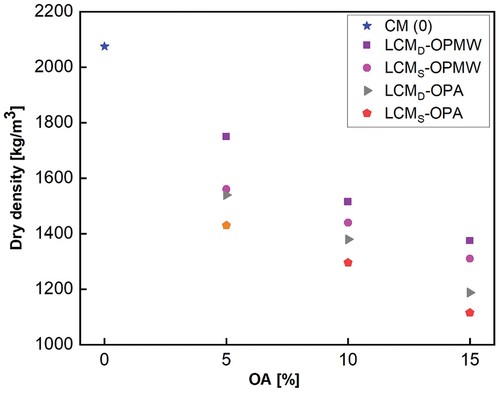
We can also note that the density of specimens prepared with OPA is always underestimated compared to the density of mortars made with OPMW. This is due mainly to the density difference between OPA (1490.96 kg/m3) and OPMW (1527.78 kg/m3).
The saturation state of the OA also has a great influence on the density of the mortar specimens. Figure shows that, regardless of the type of OA used and the percentage of substitutions, the dry bulk density of mortars made with OA at dry state is constantly greater than that of the specimens manufactured with OA at saturated state. This could be explained by the formation of pores during the mixing process of specimens containing saturated aggregates.
Finally, we record that the difference of density between the mortar specimen prepared with 5% of OPMW at dry state (LCMD_OPMW (5)) and the reference mortar is only 15.6%. In principle, this result could contribute to reducing the construction costs and the size of foundations. To confirm these results, a series of destructive tests were carried out in order to quantify the compressive and the flexural strength of the specimens.
3.2.3. Porosity accessible to water
The porosity accessible to water for cement mortar is an important property that determines the ability of the mortar to absorb and transport water. The porosity accessible to water is the volume of interconnected pores in the mortar that are large enough to allow water to pass through. Several factors can impact the accessible porosity for water, such as the water-to-cement ratio, the type and quantity of admixtures used, the curing conditions, and the composition of the cement. According to Figure the incorporation of OA into mortar increases highly its porosity regardless of the type of OA used and the percentage of substitutions. The porosity of mortar ranged between 12% and 18.58% depending on the state saturation, the type and the amount of OA incorporated in the mixture. Replacing sand with OA results, after 28 days of curing and compared to the reference mortar, in an increase in porosity of about 8%, 17%, 38%, and 41% for LCMD_OPMW (5), LCMS_OPMW (5), LCMD_OPA (5), and LCMS_OPA (5), respectively. This behavior is mainly due, as it will be seen later in this paper, to the weak adhesion between the OA and the cementitious matrix and to the increase of pores distribution in the mixtures.
3.2.4. Destructive tests and microstructural analysis
3.2.4.1. Compressive strength
We conducted compressive strength tests on LCM specimens using a carefully designed and standardized method, following guidelines of CitationASTM C109/C109M, to ensure accuracy and reliability. The cubic specimens were selected to provide a representative sample of the larger mixture, and were kept under optimal conditions, such as controlled temperature, humidity, throughout the testing period. We used the gathered data to assess the relationship between compressive strength and the properties of the LCM specimens, such as water–cement ratio, OA content, curing time, and aggregate type. The relationship between strength and each of these properties can be determined through interpretation of the results. Compressive strength tests were performed on 63 cubic specimens. Figure shows the different results obtained where the vertical error bars indicate the standard deviations recorded for different varieties of mortar specimens. In the first hand, we notice that, for all curing times, the use of OA does not involve any improvement but leads to a significant decrease in the compressive strength that is deteriorated more by increasing the percentage of OA in the mixtures. These results are in agreement with those reported in the literature for composite mortars (Alkheder et al., Citation2016; Corinaldesi et al., Citation2016; Raut & Gomez, Citation2016). As an illustration, a recent research (Cheboub et al., Citation2020) has indicated that, after 91 days of curing, the loss of compressive strength of SCLM25, SCLM50, SCLM75 and SCLM100 (mortar specimens containing different percentages of olive kernel shells), was found to be 39, 46, 63, and 75%, respectively. In the second hand, and for the same amount of OA, the compressive strength of LCMD is always higher than that measured for LCMS. Furthermore, the compressive strength values of mortar specimens made with OPMW are higher than those recorded for mortar specimens elaborated with OPA.
Figure 10. Evolution of the compressive strengths according to the amount of OA and the age of curing for: (a) LCM made with OPMW (b) LCM made with OPA.
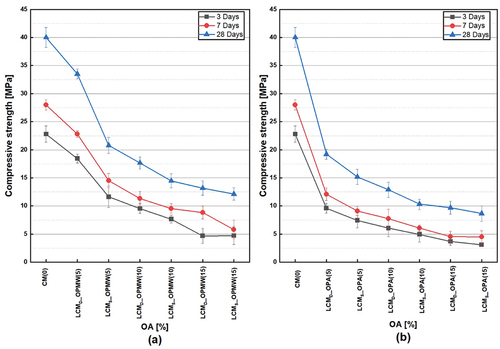
The optimal compressive strength was achieved, after 28 days of curing, for LCMD_OPMW (5) which is less than the reference mortar specimen value of about 16.48%. However, for all other LCM specimens, the loss in compressive strength was more significant (greater than 50%).
Since the dry density, ρ (kg/m3), and the compressive strength, Rc (MPa), of the LCM specimens are primarily very sensitive to the amount of the OA used in the mixtures, a strong correlation between Rc and ρ exists as illustrated in Figure . As shown by EquationEquation 3(3)
(3) - EquationEquation 4
(4)
(4) , a good correlation is obtained for the two types of the OA used in this study:
Figure 11. Correlation between dry density values and compressive strengths of the (a) LCM made with OPMW (b) LCM made with OPA.
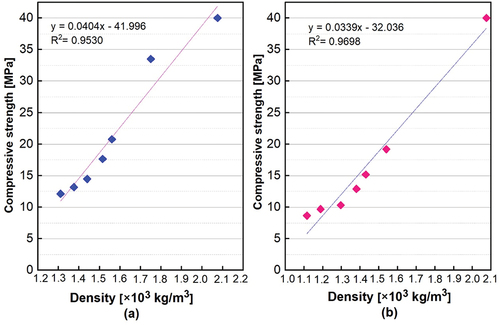
3.2.4.2. The flexural strength
The LCM specimens were prepared in accordance with the guidelines of CitationNF EN 196–1 and a series of experiments were conducted. The flexural strength of each specimen was determined using a three-point bending test, and the data was analyzed to identify the specimen with the highest strength. Figure shows the flexural strength of the different elaborated LCM specimens. Firstly, as can be seen, the flexural strength of all the specimens is underestimated compared to the reference mortar. Furthermore, and similarly to the tendency of the compressive strength, the flexural strength of the mortar specimens decreases as well as the number of OA increases in the mixture regardless the saturation state of the aggregates. The same behavior was observed in some studies reported in the literature (Alkheder et al., Citation2016; Sathiparan & Zoysa, Citation2018). For example, laboratory tests indicated that a 100% substitution of crushed olive kernels resulted in a 61% decrease in flexural strength compared to the control mortar (Cheboub et al., Citation2020).
3.2.4.3. Microstructural analysis
To compare the microstructures of the cement mortar produced, we used the scanning electron microscope (SEM) after a standard curing and testing period of 28 days. The experimental group consisted of the LCMD_OPMW(5) sample, while the control group was the CM(0) sample. By examining their microstructures using SEM, we analyzed their characteristics, including pore size, distribution, morphology, and identify any differences. This approach provided a more comprehensive understanding of how the addition of 5% of OA particles impacted the microstructure of the lightened cement mortar. It has long been recognized that the strength of cementitious materials is strongly affected by the properties of the interfacial transition zone (ITZ) between the cementitious matrix and the aggregates. Due to the better mechanical properties of the LCMD_OPMW(5) mortar specimen, SEM analysis was carried out on this specimen and the results are confronted to SEM analysis of the control mortar CM(0) specimen.
Results are presented in and reveals that:
SEM analysis showed that a good adhesion between the matrix and natural aggregates is obtained;
OPMW acts as a filer and does not react with the cement hydrate;
The contact between the matrix and OPMW is not perfect; this behaviour is certainly due to the presence of vacuum within the ITZ;
OPMW exhibit, at the ITZ level, a low adhesion and weak links with regard to the cementitious matrix. This reduces the quality of the mortars as well as the compressive strength;
Some microcracks are mainly distributed around the ITZ level;
Substituting natural sand by OPMW increases the porosity of the specimens.
From these observations, that are in good agreement with those obtained by (Cheboub et al., Citation2020), the decrease in the weight of the specimens as well as the deterioration of their mechanical properties, is mainly due to the increase of the porosity and pores distribution in the mixtures when the number of OA increases.
3.2.5. Non-destructive test: UPV and modulus elasticity analysis
The UPV technique was used as a non-destructive method to measure the mechanical properties of the mortar structure without causing any damage. In accordance with the CitationNF EN 12,504–4 standard , sound waves were transmitted through the sample from one side to the other and the pulse velocity was measured. The UPV technique was found to be a reliable and effective approach for inspecting the mechanical properties of cement mortar structures. After 28 days of curing, UPV tests were carried out on cubic specimens elaborated from the various formulations given in Table . In what follows, the quality grade of mortars, classification and interpretations of the results were performed according to the specifications given by Leslie and Cheeseman (Table ) (Leslie et al., Citation2017). Results of UPV measurements are presented in Figure . As can be seen, UPV decreases as the amount of OA increase in all mixtures, regardless of the type of mortar and its composition. Furthermore, the specimen LCMD_OPMW (5) is considered as good-quality cement mortar since its UPV (3.65 km/s) is between 3.6 km/s and 4.5 km/s. However, the remaining specimens have a medium to poor quality with a UPV below 3.0 km/s. This outcome can be attributed mainly, as explained by the SEM analysis, to the decrease in porosity of the cementitious matrix and to the porous morphology of Organic Aggregates (Mo et al., 2020). Similar results are obtained in the literature indicating that (UPV) values decrease with increasing incorporation of olive kernel shells as aggregate in self-compacting lightweight mortar (Cheboub et al., Citation2020). Other authors have also reported similar observations using rice husks ach in concrete (Padhi et al., Citation2018).
Table 4. Relation between concrete quality and UPV
Hence, UPV measurement reflects the change of the internal structure of the lightened mortars. In this context, it is interesting to establish a correlation between the UPV and the compressive strength measurements for the various elaborated cubic specimens. Figure shows the linear regression equation between the two variables for all mixtures. As can be observed, a good correlation is obtained since the regression coefficient value for all mixtures is R = 0.96. Hence, EquationEquations (5(5)
(5) -Equation6
(6)
(6) ) can be used to estimate the compressive strength with a good accuracy as a function of the UPV values:
Figure 15. Correlation between the UPV and compressive strengths for: (a) LCM made with OPMW (b) LCM made with OPA.

Based on the UPV measurements (V), it is possible to calculate the dynamic modulus of elasticity (Ed) in accordance with the following equation:
where g is the gravitational acceleration.
The Ed results for different mortar mixes are shown in . Compared to the reference mortar, the Ed follows the same tendency to that observed for Rc, so it decreases as well as the number of OA increases in the mortar mixture. Since the Ed is proportional to UPV and the density, it can reflect the quality of the cement mortar when OA are incorporated as a partial substitute for natural sand.
4. Conclusion
This paper provides new insights into the field of sustainable construction materials. The study explored the feasibility of using olive aggregates (OA) as a partial replacement for natural sand with percentages ranging from 0% (reference cement mortar) to 15% with a step of 5% in lightened cement mortar (LCM). The fresh and hardened mechanical properties of the developed composites were experimentally measured and compared to the properties of the reference cement mortar. The workability, density, porosity, compressive, and flexural strength of the LCM were evaluated with varying amounts of OA in both saturated and dry states. The results indicate that the incorporation of OA in the mixture significantly reduces the workability and dry bulk density of the mortar specimens. However, the porosity of the mortar increases considerably due to the weak adhesion between OA and the cementitious matrix, leading to an increase in the size and distribution of pores. The compressive and flexural strength of the LCM decreases with an increase in the OA content, but the specimens made with 5% of OPMW show a slightly lower strength reduction. The findings suggest that using 5% of OPMW can result in eco-friendly, lightweight, and porous LCM with reduced construction costs and foundation sizes. Several key conclusions can be drawn from the analysis of the results, as follows:
Using OA as partial replacement of natural sand (2675.64 kg/m3) leads to a decrease in the dry density of the hardened cement mortar, especially in the case of mortars containing OPA (1490.96 kg/m3).
Generally, the results reveal that the workability of the mortar specimens decreases with increasing the amount of OA. Furthermore, this behavior is significant for mixtures made by OA at the saturated state.
The partial replacement of a volume of sand with OA increases the porosity of LCM composites compared to that of the reference mortar.
Compressive strength and flexural strength of the elaborated lightened cement mortars decreased with increasing amount of OA in the mixture.
The use of OA reduces the ultrasonic pulse velocity (UPV) and hence the dynamic modulus of elasticity since this former one is proportional to the UPV and to the dry density of the cement mortar.
Analysis of the results reveals that the specimen containing (5%) of OPMW at dry state (LCMD_OPMW (5)) has reached the best mechanical performances (UPV = 3.65 km/s and Rc = 33.5 Mpa after 28 days of curing) compared to the reference mortar and confirms that it meets the standard requirements for a general use as a construction material.
With a density of 1750 kg/m3, the LCMD_OPMW (5) specimen could contribute to reducing the construction costs and the size of foundations.
Although these findings are promising and could pave the way for manufacturing a good-quality cement mortar, further studies are needed to fully understand the benefits of using OA to enhance the thermal resistance of buildings. This specific property has not yet been thoroughly studied, and more research is necessary to gain a deeper understanding of the thermal characteristics of cement mortar containing OA. The study has certain limitations that should be considered when interpreting the results, and there is potential for further research in this area. Firstly, the study only evaluated the performance of the mixtures after 28 days of curing, and the long-term durability of the mixtures under different environmental conditions remains to be determined. As a result, future research could explore the durability of the mixtures by testing them under various environmental conditions, such as exposure to freeze-thaw cycles or acidic environments and assessing their resistance to environmental exposure. Furthermore, the economic aspects of substituting natural sand with OA were not examined in the study. Hence, future studies could evaluate the economic feasibility of using OA as a sustainable alternative to natural sand.
Highlights
Two types of olive aggregates were used in cement mortar as a partial replacement for natural sand.
Mixture workability is mainly affected by the saturation state and the percentage of substitution.
The compressive and flexural strengths decreased with increasing the amount of olive aggregates in the mixture.
Interesting mechanical properties are obtained for the mortar specimen containing 5% of olive pomace aggregates mixed with olive mill wastewater at dry state.
Acknowledgments
The authors appreciate the excellent technical support provided by LM2G laboratory, Casablanca.
Disclosure statement
The authors declare that they have no known conflicts of interest associated with this publication.
References
- Al-Akhras, N. M., & Abdulwahid, M. Y. (2010). Utilisation of olive waste ash in mortar mixes. Structural Concrete, 11(4), 221‑228. https://doi.org/10.1680/stco.2010.11.4.221
- Alengaram, U. J., Muhit, B. A. A., & Bin Jumaat, M. Z. (2013). Utilization of oil palm kernel shell as lightweight aggregate in concrete – a review ». Construction and Building Materials, 38, 161‑172. janv. 2013. https://doi.org/10.1016/j.conbuildmat.2012.08.026
- Alkheder, S., Obaidat, Y. T., & Taamneh, M. (2016). Effect of olive waste (Husk) on behavior of cement paste ». Case Studies in Construction Materials, 5, 19‑25. déc. 2016. https://doi.org/10.1016/j.cscm.2016.05.001
- Alsalami, Z. H. A. Study the effect of partially replacement sand by waste pistachio shells in cement mortar ». (2017). Applied Adhesion Science, 5(1), 19. déc. 2017. https://doi.org/10.1186/s40563-017-0099-3
- ASTM International - ASTM C109/C109M-20A - Standard Test Method for Compressive Strength of Hydraulic Cement Mortars (Using 2-in. or [50-mm] Cube Specimens) | Engineering360. https://standards.globalspec.com/std/14137338/ASTM%20C109/C109M-20a ( consulté le 3 mars 2022).
- Barreca, F., & Fichera, C. R. (2013). Use of olive stone as an additive in cement lime mortar to improve thermal insulation ». Energy & Buildings, 62, 507‑513. juill. 2013. https://doi.org/10.1016/j.enbuild.2013.03.040
- Boumhaout, M., Boukhattem, L., Hamdi, H., Benhamou, B., & Nouh, F. A. (2017). Thermomechanical characterization of a bio-composite building material: Mortar reinforced with date palm fibers mesh ». Construction and Building Materials, 135, 241‑250. mars 2017. https://doi.org/10.1016/j.conbuildmat.2016.12.217
- Brasileiro, G. A. M., Vieira, J. A. R., & Barreto, L. S. (2013). Use of coir pith particles in composites with Portland cement ». Journal of Environmental Management, 131, 228‑238. déc. 2013. https://doi.org/10.1016/j.jenvman.2013.09.046
- Carr, M. K. V. (2013, Oct). THE WATER RELATIONS and IRRIGATION REQUIREMENTS of OLIVE (Olea europaea L.): A REVIEW. Experimental Agriculture, 49(4), 597‑639. https://doi.org/10.1017/S0014479713000276
- Cheboub, T., Senhadji, Y., Khelafi, H., & Escadeillas, G. (2020). Investigation of the engineering properties of environmentally-friendly self-compacting lightweight mortar containing olive kernel shells as aggregate ». Journal of Cleaner Production, 249, 119406. mars 2020. https://doi.org/10.1016/j.jclepro.2019.119406
- Corinaldesi, V., Mazzoli, A., Siddique, R., Characterization of lightweight mortars containing wood processing by-products waste », Construction and Building Materials, vol. 123, p. 281‑289, oct. 2016, https://doi.org/10.1016/j.conbuildmat.2016.07.011.
- Cruz-Yusta, M., Mármol, I., Morales, J., & Sánchez, L. Use of olive biomass fly ash in the preparation of environmentally friendly mortars ». (2011). Environmental Science & Technology, 45(16), 6991‑6996. août 2011. https://doi.org/10.1021/es200968a
- Elkacmi, R., Boulmal, N., Kamil, N., & Bennajah, M. (2017). Techno-economical evaluation of a new technique for olive mill wastewater treatment ». Sustainable Production and Consumption, 10, 38‑49. avr. https://doi.org/10.1016/j.spc.2016.12.004
- González-López, J. R., Ramos Lara, J. F., Zaldivar-Cadena, A., Chávez-Guerrero, L., Magallanes-Rivera, R. X., & Burciaga-Díaz, O. (2015). Small addition effect of agave biomass ashes in cement mortars ». Fuel Processing Technology, 133, 35‑42. mai 2015. https://doi.org/10.1016/j.fuproc.2014.12.041
- Islam, M. M. U., Mo, K. H., Alengaram, U. J., & Jumaat, M. Z. (2016). Mechanical and fresh properties of sustainable oil palm shell lightweight concrete incorporating palm oil fuel ash ». Journal of Cleaner Production, 115, 307‑314. mars 2016. https://doi.org/10.1016/j.jclepro.2015.12.051
- Johnson Alengaram, U., Jumaat, M. Z., Mahmud, H., & Fayyadh, M. M. Shear behaviour of reinforced palm kernel shell concrete beams ». (2011). Construction and Building Materials, 25(6), 2918‑2927. juin 2011. https://doi.org/10.1016/j.conbuildmat.2010.12.032
- Jumaat, M. Z., Alengaram, U. J., Ahmmad, R., Bahri, S., & Islam, A. B. M. S. (2015). Characteristics of palm oil clinker as replacement for oil palm shell in lightweight concrete subjected to elevated temperature ». Construction and Building Materials, 101, 942‑951. déc. 2015. https://doi.org/10.1016/j.conbuildmat.2015.10.104
- Krobba, B., Bouhicha, M., Kenai, S., & Courard, L. (2018). Formulation of low cost eco-repair mortar based on dune sand and Stipa tenacissima microfibers plant ». Construction and Building Materials, 171, 950‑959. mai 2018. https://doi.org/10.1016/j.conbuildmat.2018.03.200
- Leslie, J. R., Cheeseman, W. J., Leslie, J. R., & Cheeseman, W. J.(1949). An ultrasonic method of studying deterioration and cracking in concrete structures ACI. J Proc 46(1) 17
- Liuzzi, S., Sanarica, S., & Stefanizzi, P. (2017). Use of agro-wastes in building materials in the Mediterranean area: A review ». Energy Procedia, 126, 242‑249. https://doi.org/10.1016/j.egypro.2017.08.147
- Mo, K. H., Alengaram, U. J., & Jumaat, M. Z. (2015). Experimental investigation on the properties of lightweight concrete containing waste oil palm shell aggregate ». Procedia Engineering, 125, 587‑593. https://doi.org/10.1016/j.proeng.2015.11.065
- Mo, K. H., Alengaram, U. J., Jumaat, M. Z., Liu, M. Y. J., & Lim, J. (2016). Assessing some durability properties of sustainable lightweight oil palm shell concrete incorporating slag and manufactured sand ». Journal of Cleaner Production, 112, 763‑770.https://doi.org/10.1016/j.jclepro.2015.06.122
- Mo, K. H., Yap, S. P., Alengaram, U. J., Jumaat, M. Z., & Bu, C. H. (2014). Impact resistance of hybrid fibre-reinforced oil palm shell concrete ». Construction and Building Materials, 50, 499‑507. janv. 2014. https://doi.org/10.1016/j.conbuildmat.2013.10.016
- Nait M’Barek, H., Arif, S., Taidi, B., & Hajjaj, H. (2020). Consolidated bioethanol production from olive mill waste: Wood-decay fungi from central Morocco as promising decomposition and fermentation biocatalysts ». Biotechnology Reports, 28, e00541.https://doi.org/10.1016/j.btre.2020.e00541
- NF EN 1015-10, Methods of test for mortar for masonry - Part 10 : determination of dry bulk density of hardened mortar. Afnor EDITIONS. www.boutique.afnor.org/en-gb/standard/nf-en-101510/methods-of-test-for-mortar-for-masonry-part-10-determination-of-dry-bulk-de/fa037053/17562 consulté le 16 avril 2022
- NF EN 1015-2, Methods of test for mortar for masonry - Part 2 : bulk sampling of mortars and preparation of test mortars, Afnor EDITIONS. www.boutique.afnor.org/en-gb/standard/nf-en-10152/methods-of-test-for-mortar-for-masonry-part-2-bulk-sampling-of-mortars-and-/fa037042/10526 ( consulté le 3 mars 2022).
- NF EN 1015-3, Methods of test for mortar for masonry - Part 3 : determination of consistence of fresh mortar (by flow table), Afnor EDITIONS. https://www.boutique.afnor.org/en-gb/standard/nf-en-10153/methods-of-test-for-mortar-for-masonry-part-3-determination-of-consistence-/fa037043/10531 ( consulté le 3 mars 2022).
- NF EN 12504-4, Testing concrete - Part 4 : determination of ultrasonic pulse velocity. Afnor EDITIONS.
- NF EN 196-1, Methods of testing cement - Part 1 : determination of strength, Afnor EDITIONS. www.boutique.afnor.org/en-gb/standard/nf-en-1961/methods-of-testing-cement-part-1-determination-of-strength/fa184622/57803/ ( consulté le 3 mars 2022).
- NF EN 933-1,Tests for geometrical properties of aggregates - Part 1 : determination of particle size distribution - Sieving method. Afnor EDITIONS.
- NF P18-459, Concrete - Testing hardened concrete - Testing porosity and density. Afnor EDITIONS. https://www.boutique.afnor.org/en-gb/standard/nf-p18459/concrete-testing-hardened-concrete-testing-porosity-and-density/fa160729/34961 consulté le 16 avril 2022
- Padhi, R. S., Patra, R. K., Mukharjee, B. B., & Dey, T. (2018). Influence of incorporation of rice husk ash and coarse recycled concrete aggregates on properties of concrete. Construction and Building Materials, 173, 289‑297. juin 2018. https://doi.org/10.1016/j.conbuildmat.2018.03.270
- Prusty, J. K., & Patro, S. K. (2015). Properties of fresh and hardened concrete using agro-waste as partial replacement of coarse aggregate – a review ». Construction and Building Materials, 82, 101‑113. mai 2015. https://doi.org/10.1016/j.conbuildmat.2015.02.063
- Prusty, J. K., Patro, S. K., & Basarkar, S. S. Concrete using agro-waste as fine aggregate for sustainable built environment – a review. (2016). International Journal of Sustainable Built Environment, 5(2), 312‑333. déc. 2016. https://doi.org/10.1016/j.ijsbe.2016.06.003
- Raut, A. N., & Gomez, C. P. (2016, Nov). Thermal and mechanical performance of oil palm fiber reinforced mortar utilizing palm oil fly ash as a complementary binder ». Construction and Building Materials, 126, 476‑483. https://doi.org/10.1016/j.conbuildmat.2016.09.034
- Sathiparan, N., & Zoysa, H. T. S. M. D. (2018). The effects of using agricultural waste as partial substitute for sand in cement blocks ». Journal of Building Engineering, 19, 216‑227. sept. 2018. https://doi.org/10.1016/j.jobe.2018.04.023
- Usman, M., Khan, A. Y., Farooq, S. H., Hanif, A., Tang, S., Khushnood, R. A., & Rizwan, S. A. (2018). Eco-friendly self-compacting cement pastes incorporating wood waste as cement replacement: A feasibility study. Journal of Cleaner Production, 190, 679‑688. juill. 2018. https://doi.org/10.1016/j.jclepro.2018.04.186

